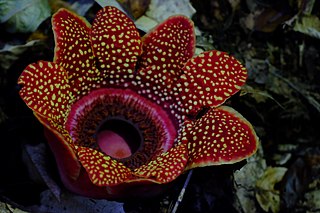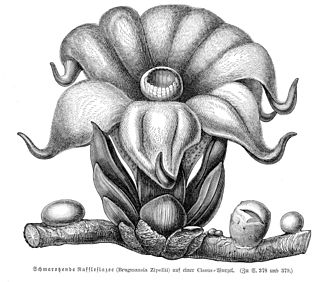
Rafflesia, or stinking corpse lily, is a genus of parasitic flowering plants in the family Rafflesiaceae. The species have enormous flowers, the buds rising from the ground or directly from the lower stems of their host plants; one species has the largest flower in the world. Plants of the World Online lists up to 41 species from this genus; all of them are found throughout Southeast Asia.

Rafflesia arnoldii, the corpse flower, or giant padma, Its local name is Petimum Sikinlili. It is a species of flowering plant in the parasitic genus Rafflesia within the family Rafflesiaceae. It is noted for producing the largest individual flower on Earth. It has a strong and unpleasant odor of decaying flesh. It is native to the rainforests of Sumatra and Borneo. Although there are some plants with larger flowering organs like the titan arum and talipot palm, those are technically clusters of many flowers.

The Rafflesiaceae are a family of rare parasitic plants comprising 36 species in 3 genera found in the tropical forests of east and southeast Asia, including Rafflesia arnoldii, which has the largest flowers of all plants. The plants are endoparasites of vines in the genus Tetrastigma (Vitaceae) and lack stems, leaves, roots, and any photosynthetic tissue. They rely entirely on their host plants for both water and nutrients, and only then emerge as flowers from the roots or lower stems of the host plants.

Tetrastigma is a genus of plants in the grape family, Vitaceae. The plants are lianas that climb with tendrils and have palmately compound leaves. Plants are dioecious, with separate male and female plants; female flowers are characterized by their four-lobed stigmas. The species are found in subtropical and tropical regions of Asia, Malaysia, and Australia, where they grow in primary rainforest, gallery forest and monsoon forest and moister woodland. Species of this genus are notable as being the sole hosts of parasitic plants in the family Rafflesiaceae, one of which, Rafflesia arnoldii, produces the largest single flower in the world. Tetrastigma is the donor species for horizontal gene transfer to Sapria and Rafflesia due to multiple gene theft events.

Sapria is a genus of parasitic flowering plants in the family Rafflesiaceae. It grows within roots of Vitis and Tetrastigma. The genus is limited to the tropical forests of South and Southeast Asia.

Rafflesia tuan-mudae is a member of the Rafflesiaceae family. It lives as a parasite within the Tetrastigma vines. The enormous flowers may reach over 1 m in diameter. The buds normally emerge where the vine is growing along the ground, unlike some of the other Rafflesia species whose buds can emerge from vines hanging in the air.
Rafflesia philippensis is a parasitic plant species of the Rafflesiaceae family that was named by Francisco Manuel Blanco in his Flora de Filipinas in 1845. The species is known only from a mountain located between the provinces of Laguna and Quezon, Luzon where it was first discovered. Its plant host is Tetrastigma pisicarpum. This species went unnoticed since its first description by Blanco but was rediscovered in 2003 by members of the Tanggol Kalikasan, a local environment conservation group in Quezon province who first saw and photographed the open flower of this species. It was brought to the attention of Manuel S. Enverga University (MSEUF), who formed a team composed of students and faculty to document the newly discovered Rafflesia species.
Rafflesia leonardi is a parasitic plant species of the genus Rafflesia. It is endemic to the Philippines. Rafflesia banaoana is considered to be a synonym by some sources, but is recognized as a separate species by others. R. leonardi is the fourth Rafflesia species found in Luzon and the eighth from the Philippines. It is called ngaratngat by the local Agta tribesmen.
Rafflesia patma is a parasitic plant species of the genus Rafflesia. It is only known to grow on the Indonesian island of Java, although it may have occurred on Sumatra in the past. Like other species in its genus, this plant has no leaves, stems, roots or chlorophyll, instead stealing all its nutrition from Tetrastigma lanceolaurium, a rainforest liana.

Rafflesia zollingeriana is a species of flowering plant in the family Rafflesiaceae, native to Java. Of three species of Rafflesia known from Java this species has always been the most rare and restricted, it is only known from collection locales in Banyuwangi Regency, Jember Regency and Lumajang Regency, southern East Java. It was first scientifically collected in 1902 by Sijfert Hendrik Koorders on the eastern flanks of Mount Puger Watangan, a forested hill near the beach, who described it as a new species in 1918. Many decades later a flowering plant was discovered in Meru Betiri National Park, also in the Jember Regency somewhat further down the coast to the east.

Rhizanthes lowii is a species of parasitic flowering plant without leaves, stems, roots, or photosynthetic tissue. It grows on the roots of the Tetrastigma vine. It includes the specimens with the largest measured flowers in Rhizanthes, from 25 to 43 cm across. The flowers are endothermic, not only producing their own heat, but they also have the rare ability to regulate their own temperature.
Rhizanthes deceptor is a species of parasitic flowering plant without leaves, stems, roots, or photosynthetic tissue. They grow on roots of the Tetrastigma vine. They are only found in the tropical forests of Sumatra at 500–700 m. The flowers are white, with red-brown tips, and are from 20 to 27 cm across.
Rhizanthes infanticida is a species of parasitic flowering plants without leaves, stems, roots, or photosynthetic tissue. They grow on roots of the Tetrastigma vine. They are found in the tropical forests of southern Thailand, western Malaysia, and Sumatra. The brown flowers are from 14 to 22 cm across. The flowers smell like a mammalian carcass and attract flies, which pollinate the blooms while laying their eggs inside. The flies' larvae die due to the lack of nutrients, hence the species name "infanticida".

Rhizanthes zippelii is a species of parasitic flowering plant without leaves, stems, roots, or photosynthetic tissue. Its flowers bud out of the roots of the Tetrastigma vine. It is found in the tropical rainforests of Java. The flowers are reddish-brown, with long hanging tips, and are from 12 to 29 cm across.

Balanophora is a genus of parasitic flowering plants in the family Balanophoraceae distributed from tropical Africa and Madagascar, through South and Southeast Asia, Japan, Queensland and the islands of the western Pacific. There are 25 accepted species. Many species emit an odour which possibly attracts pollinators in the same way that pollinators are attracted to Rafflesia.

Rafflesia verrucosa was first identified and characterized during a small mammal survey of Mt. Kampalili in eastern Mindanao in 2010. R. verrucosa is the tenth species of Rafflesia found in the Philippines. Rafflesia species have rare and unusual flowers known for their large size and pungent smell. Some plant enthusiasts like Frits W. Went have gone to extreme measures to see these plants in bloom. Went detailed his search for Rafflesia saying,
"I had heard, when I was in Java many years ago, that Rafflesia were to be found on an offshore island named Nusah Kembangan. This was in 1929, when it was a penal colony for major criminals. My driver on this occasion was a convicted murderer, and my guide was serving time for cannibalism."

Tetrastigma leucostaphylum, the Indian chestnut vine, is a flowering plant in the family Vitaceae. It is native to Sri Lanka, India, Nepal and South East Asia.

Ilex umbellulata is an evergreen tree species related to holly, generally four to fifteen metres in height. It is found in Southeast Asia. This tree is most often found growing in forests.
Zippelia begoniifolia is the only species of the monotypic genus Zippelia, a genus of plants in the Piperaceae, the same botanical family as that of black pepper. The species has also been spelled as Z. begoniaefolia. It is an erect, ascending, perennial herb with leaves of 6 to 12.5 cm in length. It occurs in Borneo, Cambodia, southern-central and southeast mainland China as well as Hainan, Java, Laos, Peninsular Malaysia, the Philippines, Sumatra, Thailand and Vietnam.
Rafflesia lawangensis is a species of parasitic plant in the genus Rafflesia. It is exclusively found in Bukit Lawang, a small tourist village in Mount Leuser National Park, North Sumatra, Indonesia. Previously misidentified as Rafflesia arnoldii, photographs taken in 2005 led to the eventual separation of Rafflesia lawangensis as a distinct species in 2010.













